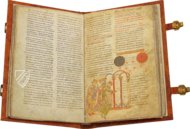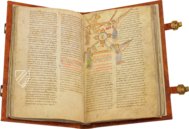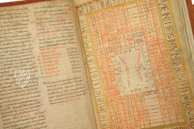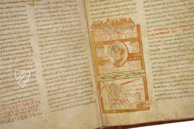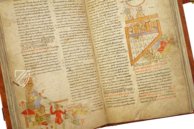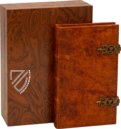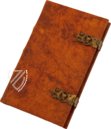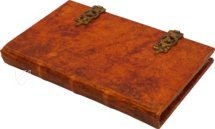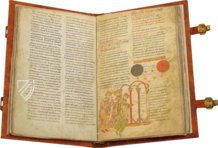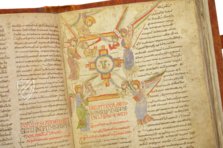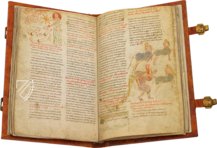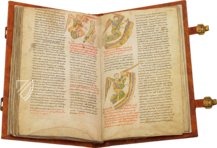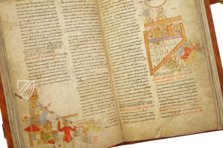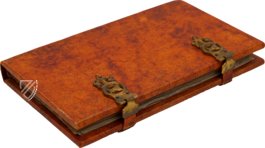Beatus of Liébana - Geneva Codex
(3,000€ - 7,000€)
In 2007, there was a sensational story for enthusiasts of old books to report from Geneva: a previously unknown Beatus manuscript resurfaced. The co-called Geneva Codex is a richly-illustrated, 11th century manuscript originating from southern Italy of the important Apocalypse commentary by the 8th century Spanish Benedictine Monk Beatus of Liébana. This edition, the 27th known Beatus, features 65 splendid and magnificent miniatures, which vividly visualizes the fantastical tales of the Apocalypse.
Beatus of Liébana - Geneva Codex
In 2007, there was a sensational story for enthusiasts of old books to report from Genf: a previously unknown Beatus manuscript resurfaced. The co-called Geneva Codex is a richly-illustrated, 11th century manuscript originating from southern Italy of the important Apocalypse commentary by the 8th century Spanish Benedictine Monk Beatus of Liébana. This edition, the 27th known Beatus, puts forth 65 splendid and magnificent miniatures, which vividly visualizes the fantastical tales of the Apocalypse.
A Sensational Event
The Brothers of the Congregation of St. Francis of Sales applied to the Bibliothèque de Genève with a sensational piece in 2007. An 11th century Beatus manuscript was found in their collection. It was completely unknown to the field of research until then and appended the 26 works known up to that time with an additional masterpiece. When and in what manner the manuscript came into the possession of the Sales Brother of Geneva remains a mystery. Yet it can be ascertained that this one was made in Southern Italy in the 11th century. The scriptorium of the Montecassino Abbey is speculated to be a possible point of origination. As a result the Geneva Beatus represents a further particularity, the rest of the 26 codices of this type are principally from northern Spain.
An Important Apocalypse Commentary of the Middle Ages
In northern Spain, Asturias to be precise, is also where the story of the so-called Beatus manuscripts begins. There the composer of the most famous apocalypse commentaries of the Middle Ages resided as a monk in the Monastery of San Martin de Turieno. To this day, the influential theologian Beatus of Liébana is known above all for his primary work, the Apocalypse commentary in 12 books originating from 776. Therein Beatus compiled the set pieces of various authors. The text of the Apocalypse of John was divided in 66 sections, each of which would be explained with a commentary by Beatus, a so-called explanation. The allegoric and symbolic images of they are supposed to make the Apocalypse more easily understood. The “end of the world” was expected in the year 800, which is probably also what induced Beatus to write his famous Apocalypse commentary.
Delicate Miniatures and Harmonious Script
The wonderful, fanciful, and often also horrible tales by John about the end of the world were illustrated in vivid images in the Geneva Beatus. For the most part, these miniatures are without frames and are integrated directly into the pages of text. The miniaturist colored the filigree drawings with delicate tones and in doing so leant the illustrations an impressive liveliness. The miniatures were also adorned with gold in many places, lending the splendid aura to the whole manuscript on 245 pages. The Beatus text was written down by the practiced scribes in Beneventan script and Carolingian miniscule in an evenly measured typeface and completed the uniform and harmonious impression of the Italian Beatus, which is housed today in Geneva.
Codicology
- Alternative Titles
- Beato de Ginebra
Genfer Beatus - Size / Format
- 245 pages / 25.0 × 16.0 cm
- Origin
- Italy
- Date
- Late 11th and early 12th century
- Epochs
- Style
- Genre
- Language
- Script
- Beneventan
- Illustrations
- 65 miniatures, the majority with gold and inserted into the text unframed
- Content
- Commentary on the Book of Revelation by Beatus of Liébana
- Artist / School
- Beatus of Liébana (died after 798) (author)
- Previous Owners
- Congregation of St. Francis de Sales
Notre-Dame d' Aulps' Abbey
Beatus of Liébana - Geneva Codex
The Seven Trumpets
When the Seventh Seal was broken (depicted in the upper left corner), there was silence in heaven for about half an hour before St. John saw seven angels appear before God. In this miniature depicting the events of Rev. 8:1-4, seven wingless angels dressed in brightly colored robes kneel with their trumpets in neatly assembled rows almost as though they were a military band. Another angel stands before the throne of God, which looks more like He is seated behind a desk, swinging a golden censer.
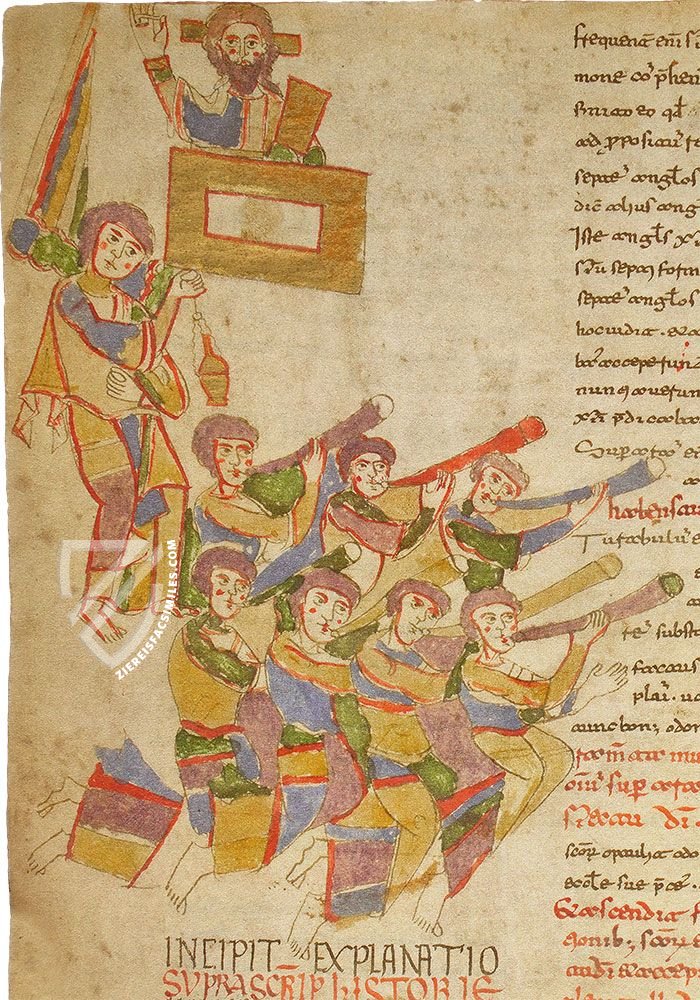
Beatus of Liébana - Geneva Codex
The New Jerusalem
At first glance, this miniature looks like a chess board with the Lamb of God, an angel, and St. John, but it is actually a schematic diagram of the New Jerusalem as described in Rev. 21:9-21. The twelve circles are gates, three each for the east, north, west, and south sides of the city wall, each of which is accompanied by an angel labelled with one of the names of the twelve tribes of Israel.
Called the bride of the Lamb of God, the city is described as being laid out as a square equal in length, breadth, and height, but is depicted here as a rectangle, perhaps simply for the sake of filling the page. The angel accompanying St. John uses a gold reed to measure the city, which is made of various precious stones with giant pearls for gates.

#1 Beato de Ginebra
(3,000€ - 7,000€)
- Treatises / Secular Books
- Apocalypses / Beatus
- Astronomy / Astrology
- Bestiaries
- Bibles / Gospels
- Chronicles / History / Law
- Geography / Maps
- Saints' Lives
- Islam / Oriental
- Judaism / Hebrew
- Single Leaf Collections
- Leonardo da Vinci
- Literature / Poetry
- Liturgical Manuscripts
- Medicine / Botany / Alchemy
- Music
- Mythology / Prophecies
- Psalters
- Other Religious Books
- Games / Hunting
- Private Devotion Books
- Other Genres
- Afghanistan
- Armenia
- Austria
- Belgium
- Colombia
- Croatia
- Cyprus
- Czech Republic
- Denmark
- Egypt
- Ethiopia
- France
- Germany
- Greece
- Hungary
- India
- Iran
- Iraq
- Israel
- Italy
- Japan
- Lebanon
- Luxembourg
- Mexico
- Morocco
- Netherlands
- Palestine
- Peru
- Poland
- Portugal
- Russia
- Serbia
- Spain
- Sri Lanka
- Sweden
- Switzerland
- Syria
- Turkey
- Ukraine
- United Kingdom
- United States
- Uzbekistan
- Aboca Museum
- Ajuntament de Valencia
- Akademie Verlag
- Akademische Druck- u. Verlagsanstalt (ADEVA)
- Aldo Ausilio Editore - Bottega d’Erasmo
- Alecto Historical Editions
- Alkuin Verlag
- Almqvist & Wiksell
- Amilcare Pizzi
- Andreas & Andreas Verlagsbuchhandlung
- Archa 90
- Archiv Verlag
- Archivi Edizioni
- Arnold Verlag
- ARS
- Ars Magna
- ArtCodex
- AyN Ediciones
- Azimuth Editions
- Badenia Verlag
- Bärenreiter-Verlag
- Belser Verlag
- Belser Verlag / WK Wertkontor
- Benziger Verlag
- Bernardinum Wydawnictwo
- BiblioGemma
- Biblioteca Apostolica Vaticana (Vaticanstadt, Vaticanstadt)
- Bibliotheca Palatina Faksimile Verlag
- Bibliotheca Rara
- Boydell & Brewer
- Bramante Edizioni
- Bredius Genootschap
- Brepols Publishers
- British Library
- C. Weckesser
- Caixa Catalunya
- Canesi
- CAPSA, Ars Scriptoria
- Caratzas Brothers, Publishers
- Carus Verlag
- Casamassima Libri
- Chavane Verlag
- Christian Brandstätter Verlag
- Circulo Cientifico
- Club Bibliófilo Versol
- Club du Livre
- CM Editores
- Collegium Graphicum
- Collezione Apocrifa Da Vinci
- Comissão Nacional para as Comemorações dos Descobrimentos Portugueses
- Coron Verlag
- Corvina
- CTHS
- D. S. Brewer
- Damon
- De Agostini/UTET
- De Nederlandsche Boekhandel
- De Schutter
- Deuschle & Stemmle
- Deutscher Verlag für Kunstwissenschaft
- DIAMM
- Droz
- E. Schreiber Graphische Kunstanstalten
- Ediciones Boreal
- Ediciones Grial
- Ediclube
- Edições Inapa
- Edilan
- Editalia
- Edition Deuschle
- Edition Georg Popp
- Edition Leipzig
- Edition Libri Illustri
- Editiones Reales Sitios S. L.
- Éditions de l'Oiseau Lyre
- Editions Medicina Rara
- Editorial Casariego
- Editorial Mintzoa
- Editrice Antenore
- Editrice Velar
- Edizioni Edison
- Egeria, S.L.
- Eikon Editores
- Electa
- Emery Walker Limited
- Enciclopèdia Catalana
- Eos-Verlag
- Ephesus Publishing
- Ernst Battenberg
- Eugrammia Press
- Extraordinary Editions
- Fackelverlag
- Facsimila Art & Edition
- Facsimile Editions Ltd.
- Facsimilia Art & Edition Ebert KG
- Faksimile Verlag
- Feuermann Verlag
- Folger Shakespeare Library
- Franco Cosimo Panini Editore
- Friedrich Wittig Verlag
- Fundación Hullera Vasco-Leonesa
- G. Braziller
- Gabriele Mazzotta Editore
- Gebr. Mann Verlag
- Gesellschaft für graphische Industrie
- Getty Research Institute
- Giovanni Domenico de Rossi
- Giunti Editore
- Graffiti
- Grafica European Center of Fine Arts
- Guido Pressler
- Guillermo Blazquez
- Gustav Kiepenheuer
- H. N. Abrams
- Harrassowitz
- Helikon
- Hendrickson Publishers
- Henning Oppermann
- Herder Verlag
- Hes & De Graaf Publishers
- Hoepli
- Holbein-Verlag
- Hortus Deliciarum
- Houghton Library
- Hugo Schmidt Verlag
- Idion Verlag
- Il Bulino, edizioni d'arte
- ILte
- Imago
- Insel Verlag
- Instituto Nacional de Antropología e Historia
- Istituto dell'Enciclopedia Italiana - Treccani
- Istituto Ellenico di Studi Bizantini e Postbizantini
- Istituto Geografico De Agostini
- Istituto Poligrafico e Zecca dello Stato
- Italarte Art Establishments
- J. Thorbecke
- Jan Thorbecke Verlag
- Johnson Reprint Corporation
- Josef Stocker
- Josef Stocker-Schmid
- Jugoslavija
- Karl W. Hiersemann
- Kasper Straube
- Kaydeda Ediciones
- Kindler Verlag / Coron Verlag
- Kodansha International Ltd.
- Konrad Kölbl Verlag
- Kurt Wolff Verlag
- La Liberia dello Stato
- La Linea Editrice
- La Meta Editore
- Lambert Schneider
- Landeskreditbank Baden-Württemberg
- Leo S. Olschki
- Les Incunables
- Library of Congress
- Libreria Musicale Italiana
- Lichtdruck
- Lito Immagine Editore
- Lumen Artis
- Lund Humphries
- M. Moleiro Editor
- Maison des Sciences de l'homme et de la société de Poitiers
- Manuscriptum
- Martinus Nijhoff
- Maruzen-Yushodo Co. Ltd.
- MASA
- McGraw-Hill
- Militos
- Millennium Liber
- Müller & Schindler
- Nahar and Steimatzky
- National Library of Wales
- Neri Pozza
- Nova Charta
- Oceanum Verlag
- Odeon
- Orbis Mediaevalis
- Orbis Pictus
- Österreichische Staatsdruckerei
- Oxford University Press
- Pageant Books
- Parzellers Buchverlag
- Patrimonio Ediciones
- Pattloch Verlag
- PIAF
- Pieper Verlag
- Plon-Nourrit et cie
- Prestel Verlag
- Princeton University Press
- Prisma Verlag
- Priuli & Verlucca, editori
- Pro Sport Verlag
- Propyläen Verlag
- Pytheas Books
- Quaternio Verlag Luzern
- Reales Sitios
- Recht-Verlag
- Reichert Verlag
- Reichsdruckerei
- Riehn & Reusch
- Roberto Vattori Editore
- Rosenkilde and Bagger
- Roxburghe Club
- Salerno Editrice
- Sarajevo Svjetlost
- Schöck ArtPrint Kft.
- Scolar Press
- Scrinium
- Scripta Maneant
- Scriptorium
- Siloé, arte y bibliofilia
- SISMEL - Edizioni del Galluzzo
- Sociedad Mexicana de Antropología
- Société des Bibliophiles & Iconophiles de Belgique
- Soncin Publishing
- Sorli Ediciones
- Stainer and Bell
- Studer
- Styria Verlag
- Sumptibus Pragopress
- Szegedi Tudomànyegyetem
- Taberna Libraria
- Tarshish Books
- Taschen
- Tempus Libri
- Testimonio Compañía Editorial
- Thames and Hudson
- The Clear Vue Publishing Partnership Limited
- The Facsimile Codex
- The Folio Society
- The Marquess of Normanby
- The Richard III and Yorkist History Trust
- Tip.Le.Co
- TouchArt
- TREC Publishing House
- TRI Publishing Co.
- Trident Editore
- Typis Regiae Officinae Polygraphicae
- Union Verlag Berlin
- Universidad de Granada
- University of California Press
- University of Chicago Press
- Urs Graf
- Vallecchi
- Van Wijnen
- VCH, Acta Humaniora
- VDI Verlag
- VEB Deutscher Verlag für Musik
- Verlag Anton Pustet / Andreas Verlag
- Verlag Bibliophile Drucke Josef Stocker
- Verlag der Münchner Drucke
- Verlag für Regionalgeschichte
- Verlag Styria
- Vicent Garcia Editores
- W. Turnowsky
- Waanders Printers
- Wiener Mechitharisten-Congregation (Wien, Österreich)
- Wissenschaftliche Buchgesellschaft
- Wydawnictwo Dolnoslaskie
- Xuntanza Editorial
- Zakład Narodowy
- Zollikofer AG




